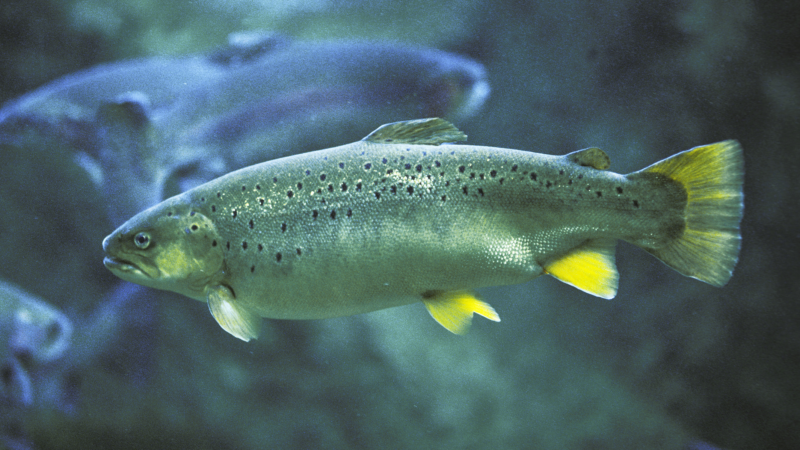Anxiety drugs found in rivers make salmon take more risks
In many streams and rivers, fish are swimming in a veritable soup of drugs. Components of that soup may be disrupting their behavior, according to a new study.
Atlantic salmon exposed to anti-anxiety medication during their migration were more successful in reaching their destination than drug-free fish, researchers reported Thursday in Science. That success may stem from increased boldness, the researchers found, a trait that could ultimately harm the fish in the long-run.
“On the face of it, it sounds like giving drugs to fish is beneficial,” said Jack Brand, a biologist at the Swedish University of Agricultural Sciences. “But any departure from natural behaviour is likely to have potential broad and negative consequences for the population.”
Scientists have detected more than 900 drug ingredients in natural waterways around the world, from antibiotics to antidepressants. Many of these drugs, especially ones that act on the mind, target parts of the brain shared by many different species.
Over the past decade or so, lab experiments have shown that naturally occurring concentrations of such drugs can alter fish behavior. In the lab, drugged fish are often more antisocial, less fearful and more prone to taking risks and finding themselves in risky situations.
But studying what these drugs do to fish out in the wild has been a lot harder, said Brand. “Obviously we can’t dump a bunch of pharmaceuticals into the river.”
Instead, he and his colleagues essentially dumped pharmaceuticals into fish just before they were set to migrate from the River Dal in Sweden to the Baltic Sea. The team implanted slow-release drugs in 279 hatchery-raised, juvenile Atlantic salmon. The implants released controlled amounts of two drugs, in varying combinations: clobazam, a benzodiazepine often used to treat anxiety, and tramadol, a pain medication.
“In human patients, tramadol and clobazam are expected to have negative interactions; they’re often not prescribed together,” said Brand. The researchers suspected that the combo could be harmful for fish, too. And while both drugs are commonly found in natural ecosystems, they aren’t detectable in this stretch of river.
They also implanted tracking tags that allowed the researchers to follow the fish as they migrated from release sites in Sweden, across multiple hydropower dams to the Baltic Sea.
Bolder salmon?
Clobazam seemed to boost the migratory success of the young salmon. More clobazam-exposed fish reached the Baltic than non-exposed fish, the researchers found. Tramadol appeared to have no effect.
Those results surprised Brand, given what’s known about how these drugs impact fish in the lab. “We sort of expected decreased survival in the wild,” he said, since increased risk taking can be dangerous. In the context of migration, it appeared to pay off. That could have something to do with the dams, which have large, spinning turbines to produce hydropower.
“If they’re struck by a blade, they can die. So that’s not good,” said Olivia Simmons, a salmon biologist at the Norwegian Institute for Nature Research who wasn’t involved in the study. Usually, these turbines slow salmon down, she said, as the fish figure out how to pass the turbines unscathed.
But the researchers found that clobazam-exposed fish traversed dams 2-3 times faster than non-exposed fish, saving an average of about 5 hours. “Maybe the bolder fish are spending less time trying to decide if they’re going to go through the scary turbines or not,” said Simmons.
Brand shares that interpretation. “We suspect that these fish exposed to clobazam are more risk prone, more solitary, and therefore just sort of bee-lining it through the dams rather than waiting around for their salmon friends,” he said.
Broader consequences
While that boldness appears to have paid off in more fish reaching the sea, it could be costly in other contexts.
“We don’t know what happened to the salmon once they got to the Baltic. Did they have better survival or worse survival?” said Karen Kidd, an ecotoxicologist at McMaster University. Subsequent lab experiments hint at a possible answer.
Brand and his colleagues found that clobazam-exposed salmon were less likely to form a school with other fish, which could make it easier for predators to pick them off.
Whatever the ultimate consequences of exposure, the study confirms that the kind of behavioral alterations seen in the lab can translate into the wild, said Kidd. “This is really where the novelty of this experiment shines because they’ve done something that no one else has done.”
Still, there are lots of unknowns.
“We have no idea what those anti-anxiety medications plus the analgesics, plus the antibiotics, you know, plus the anti-epileptic plus the chemotherapy, etc., etc., collectively are doing to fish and other aquatic species,” said Kidd. “It’s a global concern.”
There are potential solutions to the problem. Building better wastewater treatment plants could help catch these chemicals before they contaminate the environment. Drugs could also be designed to more easily break down in the environment, said Kidd.
“That’s a critical step moving forward to ensure that what’s going into the environment isn’t causing adverse harm.”
Scorching Saturdays: The rising heat threat inside football stadiums
Excessive heat and more frequent medical incidents in Southern college football stadiums could be a warning sign for universities across the country.
The Gulf States Newsroom is hiring an Audio Editor
The Gulf States Newsroom is hiring an Audio Editor to join our award-winning team covering important regional stories across Mississippi, Alabama and Louisiana.
Judge orders new Alabama Senate map after ruling found racial gerrymandering
U.S. District Judge Anna Manasco, appointed by President Donald Trump during his first term, issued the ruling Monday putting a new court-selected map in place for the 2026 and 2030 elections.
Construction on Meta’s largest data center brings 600% crash spike, chaos to rural Louisiana
An investigation from the Gulf States Newsroom found that trucks contracted to work at the Meta facility are causing delays and dangerous roads in Holly Ridge.
Bessemer City Council approves rezoning for a massive data center, dividing a community
After the Bessemer City Council voted 5-2 to rezone nearly 700 acres of agricultural land for the “hyperscale” server farm, a dissenting council member said city officials who signed non-disclosure agreements weren’t being transparent with citizens.
Alabama Public Television meeting draws protesters in Birmingham over discussion of disaffiliating from PBS
Some members of the Alabama Educational Television Commission, which oversees APT, said disaffiliation is needed because the network has to cut costs after the Trump administration eliminated all funding for public media this summer.









